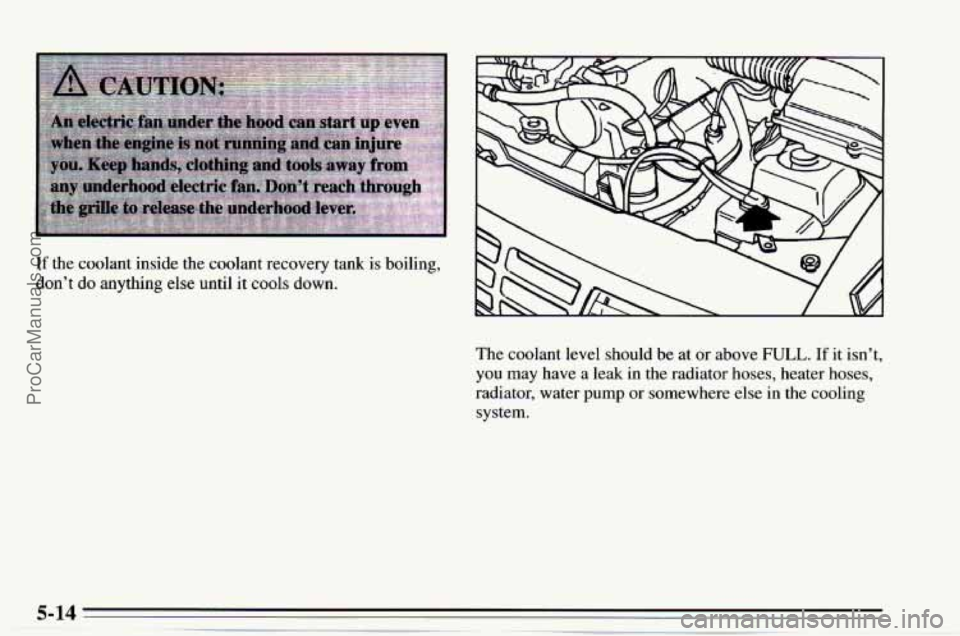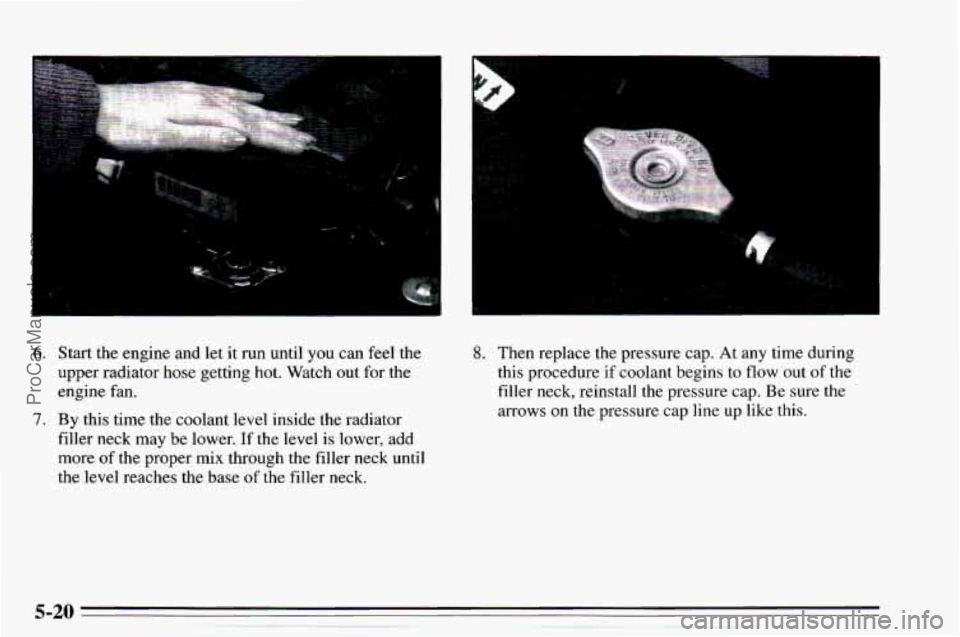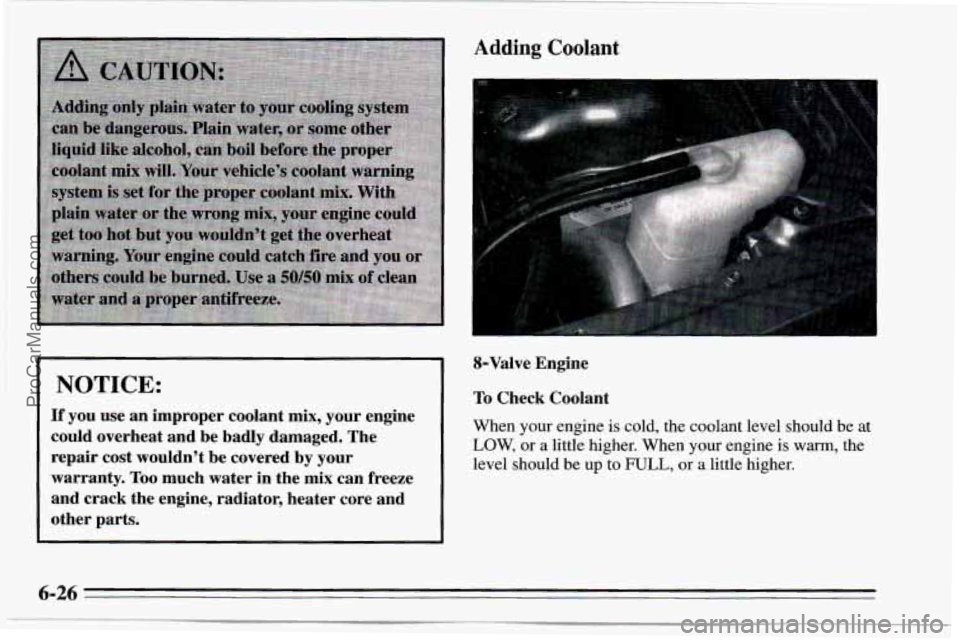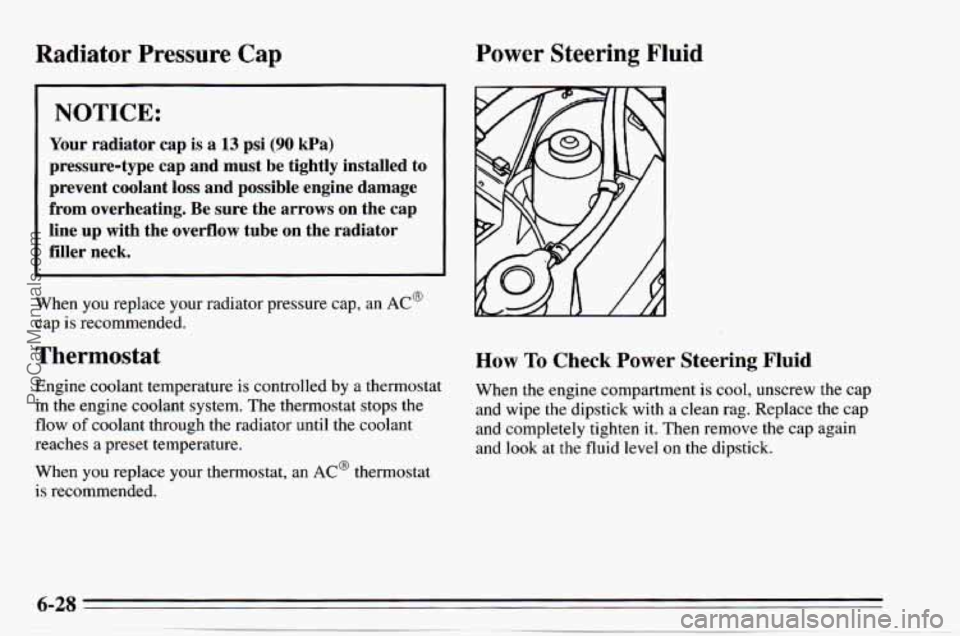1995 CHEVROLET TRACKER coolant level
[x] Cancel search: coolant levelPage 191 of 354

If the coolant inside the coolant recovery tank is boiling,
don’t do anything
else until it cools down.
The coolant level should be at or above
FULL. If it isn’t,
you may have a leak in the radiator hoses, heater hoses,
radiator, water pump or somewhere else in the cooling
system.
ProCarManuals.com
Page 192 of 354

NOTICE:
Engine damage from running your engine
without coolant isn’t covered by
your warranty.
If there seems to be no leak, with the engine on check to
see if the electric engine fan is running. If the engine is
overheating, the fan should be running.
If it isn’t, your
vehicle needs service.
How to Add Coolant to the Coolant
Recovery Tank
If you haven’t found a problem yet, but the coolant level
isn’t at
or above the FULL mark, add a 50 mixture of
clean water (preferably distilled) and a proper antifreeze
at the coolant recovery tank. (See “Engine Coolant”
in
the Index for more information about the proper coolant
mix.)
ProCarManuals.com
Page 197 of 354

6. Start the engine and let it run until you can feel the
upper radiator hose getting hot. Watch out for the
engine fan.
7. By this time the coolant level inside the radiator
filler neck may be lower.
If the level is lower, add
more
of the proper mix through the filler neck until
the level reaches the base of the filler neck.
8. Then replace the pressure cap. At any time during
this procedure
if coolant begins to flow out of the
filler neck, reinstall the pressure cap. Be sure the
arrows on the pressure cap line up like this.
5-20 ~ - . . I .. - -- . . .,.^. . . .. ProCarManuals.com
Page 236 of 354

Front Axle Engine Coolant
When to Check and Change Lubricant
Refer to the Maintenance Schedule to determine how
often to check the lubricant and when to change it. See
“Periodic Maintenance Inspections” and “Scheduled
Maintenance Services” in the Index.
How to Check Lubricant
If the level is below the bottom of the filler plug hole,
you’ll need to add some lubricant.
If the differential is at operating temperature (warm),
add enough lubricant to raise the level to the bottom of
the filler plug hole.
If the differential is cold, add enough lubricant to raise
the level to 1/2 inch (12 mm) below the filler plug hole.
What to Use
Refer to the Maintenance Schedule to determine what
kind of lubricant to use. See “Recommended Fluids and
Lubricants” in the Index. The following explains
your cooling
system and how to
add coolant when it is low. If you have a problem with
engine overheating, see “Engine Overheating’’ in the
Index.
The proper coolant for your Geo will:
0 Give freezing protection down to -33°F (-36°C).
Give boiling protection up to 258°F (125°C).
Protect against rust and corrosion.
Help keep the proper engine temperature.
Let the warning lights work as they should.
What to Use
Use a mixture of one-half clean water (preferably
distilled) and one-half antifreeze that meets
“GM
Specification 1825M,” which won’t damage aluminum
parts. You can also use a recycled coolant conforming to
GM Specification 1825M with a complete coolant flush
and refill. If you use this mixture, you don’t need to add
anything else.
ProCarManuals.com
Page 237 of 354

I NOTICE:
If you use an improper coolant mix, your engine
could overheat and be badly damaged. The
repair cost wouldn’t be covered by your
warranty.
Too much water in the mix can freeze
and crack the engine, radiator, heater core and
other parts.
Adding Coolant
8-Valve Engine
To Check Coolant
When your engine is cold, the coolant level should be at
LOW, or
a little higher. When your engine is warm, the
level should be
up to FULL, or a little higher.
6-26
ProCarManuals.com
Page 239 of 354

Radiator Pressure Cap Power Steering Fluid
I NOTICE:
Your radiator cap is a 13 psi (90 kPa)
pressure-type cap and must be tightly installed to
prevent coolant
loss and possible engine damage
from overheating. Be sure the arrows on the cap
line up with the overflow tube on the radiator
filler neck.
When you replace your radiator pressure cap, an AC@
cap is recommended.
Thermostat
Engine coolant temperature is controlled by a thermostat
in the engine coolant system. The thermostat stops the
flow of coolant through the radiator until the coolant
reaches
a preset temperature.
When
you replace your thermostat, an AC@ thermostat
is recommended.
How To Check Power Steering Fluid
When the engine compartment is cool, unscrew the cap
and wipe the dipstick with a clean rag. Replace the cap
and completely tighten it. Then remove the cap again
and look at the
fluid level on the dipstick.
ProCarManuals.com
Page 325 of 354

Part B: Owner Checks and Services
Listed below are owner checks and services which
should be performed at the intervals specified to help
ensure the safety, dependability and emission control
performance
of your vehicle.
Be sure any necessary repairs are completed at once.
Whenever any fluids or lubricants are added
to your
vehicle, make sure they are the proper ones, as shown in
Part
D.
At Each Fuel Fill
It is important for you or a service station attendant to
per3cot-m these underhood checks at each fuel fill.
Engine Oil Level
Check the engine oil level and add the proper oil if
necessary. See “Engine Oil” in the Index for further
details.
Engine Coolant Level
Check the engine coolant level and add the proper
coolant mix if necessary. See “Coolant” in the Index for
further details.
Windshield Washer Fluid Level
Check the windshield washer fluid level in the
windshield washer tank and add the proper fluid if
necessary. See “Windshield Washer Fluid” in the Index
for further details.
Hood Latch Operation
Pull the primary hood latch release handle inside the
vehicle. The secondary latch should keep the hood from
opening all
the way when the primary latch is released.
Make sure the hood closes firmly. See “Hood Release”
in the Index for further details.
At Least Once a Month
Tire Inflation
Check tire inflation. Make sure tires are inflated to the
pressures specified on the Tire-Loading Information
label located on the driver’s door lock pillar. See “Tires”
in the Index for further details.
Cassette Deck
Clean cassette deck. Cleaning should be done every
50 hours of tape play. See “Audio Systems” in the Index
for further details.
ProCarManuals.com
Page 344 of 354

Gee Section 9 Index
Adding Automatic Transmission Fluid
.................. 6-22
Brake Fluid
................................. 6-32
Electrical Equipment
.................... 2- 10. 6.59
Engine Coolant .............................. 6-26
Engineoil
.................................. 6-13
Manual Transmission Fluid
.................... 6-23
Power Steering Fluid
......................... 6-29
SoundEquipment
............................ 3-18
Windshield Washer Fluid
................. 2-3 1, 6-30
Adjustable Steering Column ...................... 2-27
Aircleaner
.................................... 6-16
Air Cleaner Filter Replacement
.................... 6- 18
Air Conditioning ................................ 3-3
Air Conditioning Controls ......................... 3-3
AirIntakeLever
................................. 3-2
Airflow Lever 3-
I
Alignment and Balance, Tires ..................... 6-46
Aluminum Wheels, Cleaning
...................... 6-56
Antifreeze
..................................... 6-25
Anti-Lock ..................................... 4-6
Anti-Lock Brakes
............................... 4-6
Appearance Care ............................... 6-49
Appearance Care and Materials
.................... 6-58
Ashtrays Front
...................................... 2-36
...................................
Antenna ...................................... 3-19 Rear
....................................... 2-37
Audio Systems
.................................. 3-5
Automatic Transmission
......................... 2-11
Drive
(D) Position ............................ 2-13
Low(L)Position
............................. 2-14
Neutral
(N) Position .......................... 2-13
Park (P) Position
............................. 2-11
Reverse (R) Position
.......................... 2-12
Second (2) Position
........................... 2-13
Starting Your Engine
........................... 2-9
Automatic Transmission Fluid
..................... 6-19
Adding .................................... 6-22
Checking
................................... 6-22
Axle, Front
.................................... 6-25
Axle, Rear
.................................... 6-24
Battery
...................................... 6-34
BBB Auto Line
................................. 8-3
Bi-Level
....................................... 3-2
Brake Warnings
.................................... 5-2
Blizzard
...................................... 4-38
Adjustment
................................. 6-33
Fluid, Adding
............................... 6-31
Master Cylinder
............................. 6-31
Parking
.................................... 2-20
PedalTravel
................................ 6-33
9-1
--.. p-.. ........ ... _-i-.-_'.-.-- ..... .=_ ___.~~~~-~_.i_i~.---~ ~~~ ..__________I ProCarManuals.com